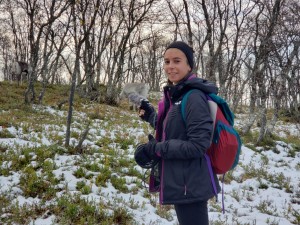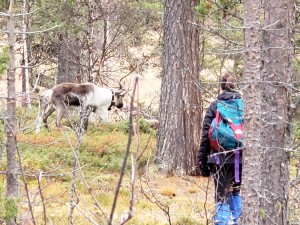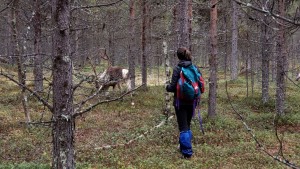Laura Puch
PhD. Student (completed MSc instead)
Contact Information
Department of Biology
Concordia University (Loyola Campus)
7141 Sherbrooke St. W. H4B 1R6
Montreal, QC, Canada
Office: SP 301.xx
Lab: SP434
(514) 848-2424 (ext. 4021)
laura.puch@laposte.net
Education
2020 – 2022: MSc in Ecology at Concordia University, Montreal, Canada
2018 – 2019: Master’s degree in Ecology & Evolution at Paul Sabatier University, Toulouse, France
2014 – 2019: Engineer’s degree in Biological Engineering at INSA (National Institute of Applied Sciences), Toulouse, France
My Project
The role of male vocalizations on sexual selection in reindeer Rangifer tarandus
Background
Over the past twenty years, animal vocal communication has received an increasing interest due to the development of new techniques in sound recording and analysis. The field has also greatly benefited from the generalisation of the source-filter theory, which allows to decompose the acoustic structure of vocal signals according to their mode of production. Studies have revealed that some acoustic parameters reliably indicate male quality and play a role in sexual selection. For example, formant frequencies act as cues to body size in some deer species and lower formants are selected by females in a mate choice context.
Deer are group-living animals, characterized by a social structure in which communication is crucial to regulate interactions. Reindeer (Rangifer tarandus) are a gregarious and polygynous species. During the autumn mating season, males establish harems, herding females and chasing rivals. Among associated rutting behaviours, they use a characteristic vocalisation. It consists of a series of short calls which sound hoarse, ‘grunts’, and are produced by a series of exhalations in rapid succession. Grunts can be directed towards females in a courtship context or towards males during agonistic interactions. To date, reindeer male vocalisations have been poorly studied.
Field Work
The field session is held in the Kutuharju Field Reindeer Research Station in Kaamanen, Finland (69°N, 27°E) and is conducted on a semi-domestic reindeer population. Each individual of the population can be identified with collars and the herd is free ranging for most of the year excluding the calving and rutting seasons. Consequently, we know which males have bred with which females and also the who is the father of individual calves. Information on the ecology and behaviour of the individual reindeer are provided by the Finnish Reindeer Herders Association who manages and harvests these animals.
For my project, we collect acoustic and behavioural data from males during the rut. We use a portable digital recorder and on-animal mini digital recorders to record their vocalisations. We also note group composition (number of females and males, and their identities) and the context of vocalisations (courting/herding females or chasing/fighting males).
Objectives
The goal of my PhD is to enhance our understanding of the role of male vocalisations in sexual selection in reindeer with a combination of field observations and recordings, acoustic analyses, and playback experiments. This will be achieved through the following four thesis chapter:
- As an essential first step, the first chapter will investigate the dynamics and ecological determinants of grunting activity.
- The second chapter will investigate which acoustic features provide honest information on male phenotype by conducting a detailed acoustic analysis on recorded male grunts.
- In the third chapter, recorded grunts will be used to conduct a playback experiment in order to test whether females use acoustic cues to male quality, highlighted in the previous chapter, in a mate choice context.
- The fourth and last chapter will examine the costs and benefits of rutting calls.
Publications
- Puch, L., Weladji, R.B., Holand, Ø. & Kumpula, J. (2020). The role of male vocalisations in sexual selection in reindeer Rangifer tarandus. Colloque virtuel SQEBC (Société Québécoise pour l’Étude Biologique du Comportement), November 2 – December 15, 2020, online (poster presentation).
- Puch, L., Weladji, R.B., Holand, Ø. & Kumpula, J. (2020). The role of male vocalisations in sexual selection in reindeer Rangifer tarandus. ABC Conference 2020 – The 2nd African Bioacoustics Community Conference, November 2-5, 2020, online (poster presentation).
- Puch, L., Weladji, R.B., Holand, Ø. & Kumpula, J. (2020). The role of male vocalisations in sexual selection in reindeer Rangifer tarandus. ABS 2020 Virtual Meeting – The 57th Annual Conference of the Animal Behavior Society, July 28-31, 2020, online (oral presentation).


